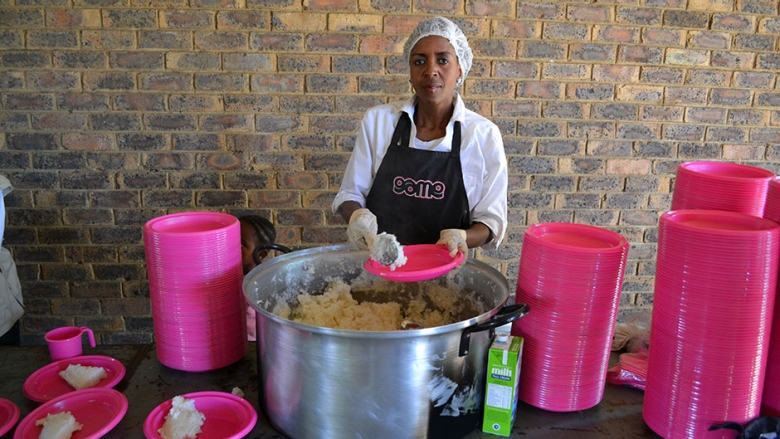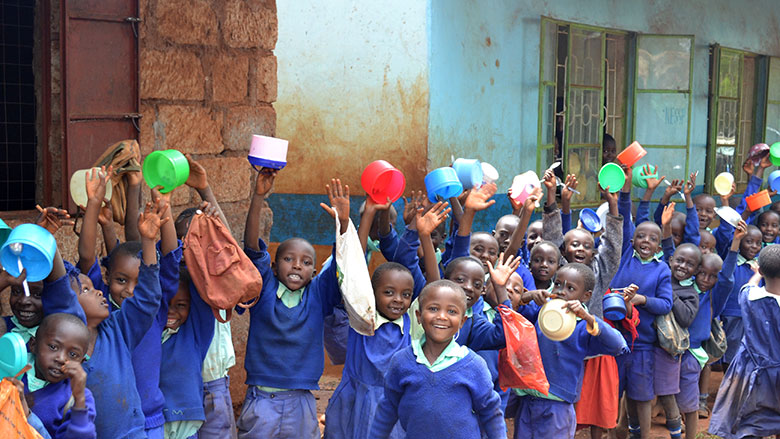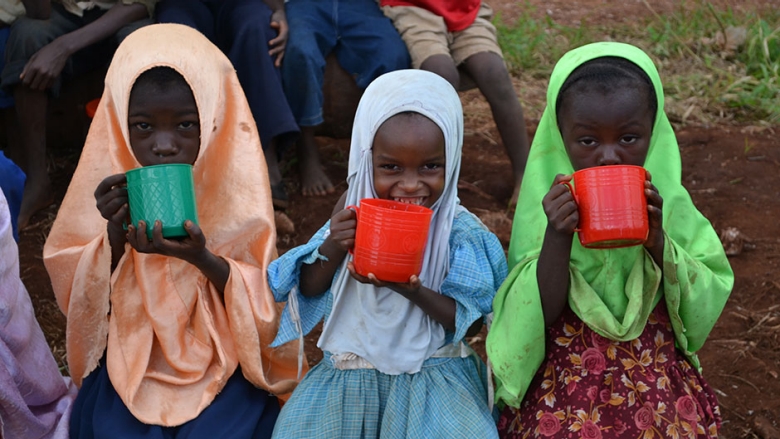WASHINGTON, June 9, 2016 – In Kenya, more than 1.5 million school children are fed a hot lunch of corn and legumes each day, the only meal many of them will have. More than 8.8 million South African students receive a cooked mid-morning meal, and those in the poorest provinces are also served lunch. Cabo Verde’s national school feeding program not only provides one hot meal a day to thousands of school children, it also employs more than 1,000 women from within the school communities.
For the first time, detailed data about national school meal programs are available in the newly-released Global School Feeding Sourcebook: Lessons from 14 Countries. Using case studies from around the world, including programs in nine countries in Sub-Saharan Africa, the sourcebook provides a comprehensive analysis of school feeding programs to identify common themes, challenges and good practices.
“I think we are now at a stage where it’s not whether school feeding is important, it’s how to design and deliver school feeding,” said Andy Tembon, World Bank senior health specialist. “This sourcebook comes at a very important moment, because it gives us an idea of how to strengthen and how to scale up school feeding programs.”
According to the analysis, the strongest and most sustainable programs are those that respond to a community need, are locally-owned and incorporate some form of parental or community involvement. In Namibia, communities are expected to provide fuel, cooking utensils and storerooms. In Mali, school feeding programs have put schools at the heart of local development by promoting locally-owned meal programs. In Ghana, the government uses a digital school meals planner to develop nutritionally balanced school meals using local ingredients.
The sourcebook is the third in a series of analysis on school feeding by the World Bank, the World Food Programme (WFP) and the Imperial College London’s Partnership for Child Development (PCD). The first, Rethinking School Feeding (WB, 2009), highlighted the long-term social investment of school feeding, and its role as a short-term productive safety net for children and families. The second, the State of School Feeding Worldwide (WFP, 2013), shows that school feeding programs serve as many as 368 million students in almost every country in the world at a global cost of $75 billion.
Developed in response to demand from governments and development partners, the sourcebook offers guidelines for designing and implementing sustainable national food programs, as well as recommendations for strengthening existing programs. Nine Sub-Saharan Africa (SSA) countries are included in the analysis: Botswana, Cabo Verde, Cote d’Ivoire, Ghana, Kenya, Mali, Namibia, Nigeria and South Africa.
“School feeding programs can help to get children into school and help keep them there, increasing enrollment and reducing absenteeism,” said World Bank Group President Jim Yong Kim and WFP’s Ertharin Cousins in a joint foreword. “While there are many successful models for rich countries, there is specific demand from governments in low and middle income countries for guidance on how to strengthen and scale up their national programs. This latest joint publication is a response to this demand.”
Lesley Drake, lead editor of the analysis and PCD’s executive director said “the overall message from the sourcebook is that there is no ‘one size fits all’ for school feeding and there are many routes to success.”
Additional key findings about school feeding programs in SSA countries in the sourcebook include:
Botswana: The government has successfully implemented its national school feeding program continuously for 45 years, witnessing enrollment growth and school attendance rates that are highly associated with the availability of food at school. There are a number of strengths, however, there is still room for improvement, and a need for more robust data, analysis and reporting.
Cabo Verde: The government has repeatedly shown its commitment to a policy of universal coverage of school feeding programs in public pre-primary and primary schools, and is now revising the objectives to meet the changing needs of communities. The major challenge is how to meet the demand to provide healthy meals and support the local economy and agriculture, while keeping the program affordable.
Cote d’Ivoire: In addition to increased school access, retention, and success, the school feeding program has sparked behavioral changes among children including hand washing, good eating habits, nutritional, and hygiene practices. For a sustainable program, the report calls for strengthened governance, capacity, monitoring and evaluation, as well as improving agricultural technical skills and the introduction of advanced agricultural technology and equipment.
Ghana: School feeding in Ghana is decentralized and outsourced, relying on caterers for food procurement, preparation and distribution. This creates jobs for the communities, and allows schools to focus on education rather than food duties. While implementation of school feeding programs need political support and commitment, the report notes it is important for the government not to politicize the program, which can affect targeting and quality.
Kenya: The country stands out for developing innovative and complementary school feeding programs, with both successes and challenges. The Njaa Marufuku Kenya (Eradicate Hunger in Kenya) program, under the Ministry of Agriculture, is geared toward agricultural development and capitalizes on the ministry’s agricultural expertise and integrates community food and nutrition security with school feeding. However, continued financing is a challenge. The Home Grown School Meals (HGSM) program, under the Ministry of Education, Science and Technology, aims to tackle low school enrollment and attendance, high dropout rates and low academic achievement. As it transitions from World Food Programme support to being government led, the program would benefit from increased links to local agriculture.
Mali: Launched three years ago, the national school feeding program has contributed to an increase in school enrollment and retention in primary schools, especially for girls. The program promotes locally-owned school feeding programs, benefitting communities through community organizations, providing training, and supporting smallholder famers. One challenge is that there has not been an impact evaluation on the program, so there is no significant data on its social and economic impacts.
Namibia: School feeding programs serve as an incentive for poor and/or marginalized learners, or those affected by HIV and AIDS to attend school more regularly and consistently perform better. However, in the past decade, the impact of the HIV pandemic, droughts, floods and the rising prices of food have shifted the program to a safety net or means of social protection rather than improved childhood nutrition. The government has increased funding to fully-finance the program, and there are also plans to expand, which will serve as an opportunity to improve it.
Nigeria: In Osun State, the innovative system of checks and balances that has been developed over the years has ensured good governance and is a model of good practice within the country and the region. Cooks procure the food every two weeks for 50 children per cook, inspiring smallholder participation. However, the funding capacity is limited; the current budget is a strain on the finances of the state.
South Africa: The school nutrition program is designed to alleviate poverty, improve access to education and academic performance through good nutrition. Meals are provided daily to more than eight million children, and there are plans to reach more. Since the beginning of its program in 1994, community participation has been identified as the key to success, with parents encouraged to volunteer and help make decisions through School Governing Bodies. Developing links between school feeding and local agriculture production more systematically could result in greater community involvement in schools and even greater economic benefits.



